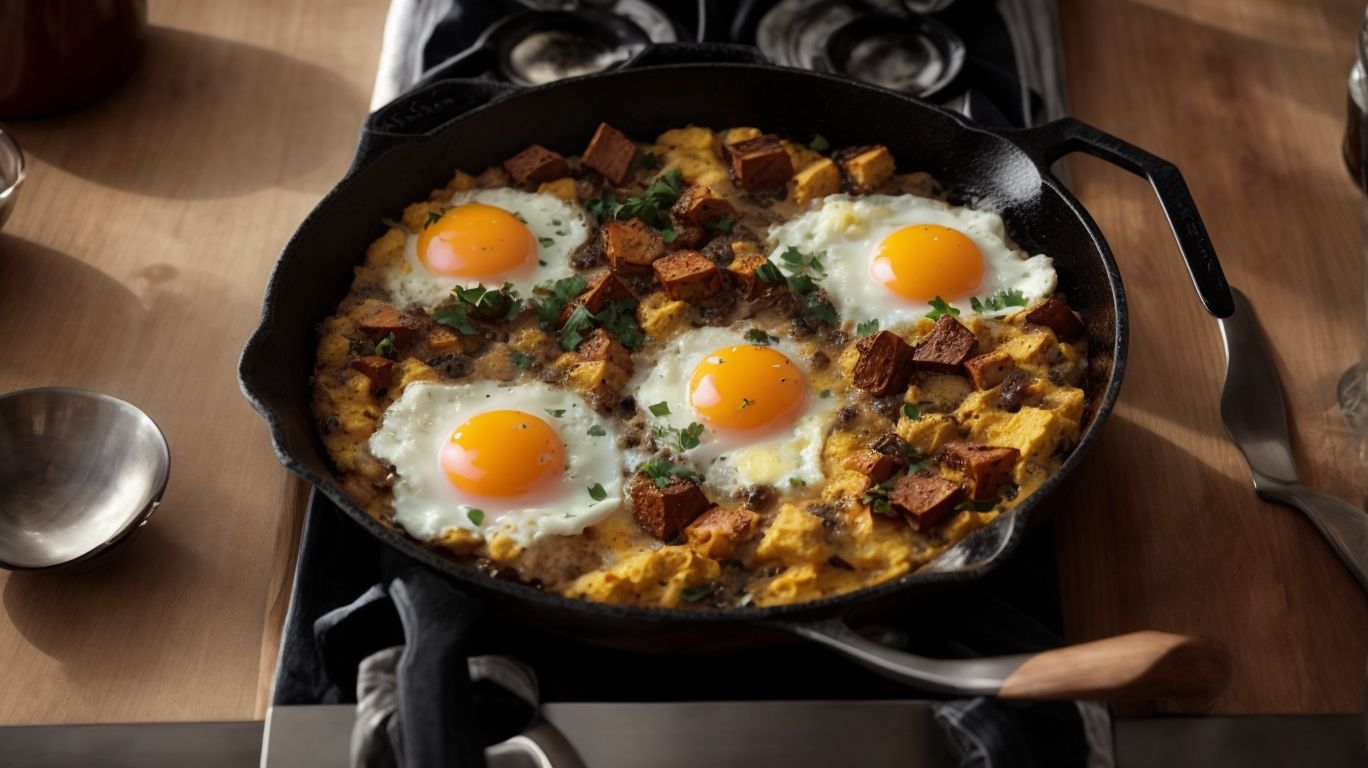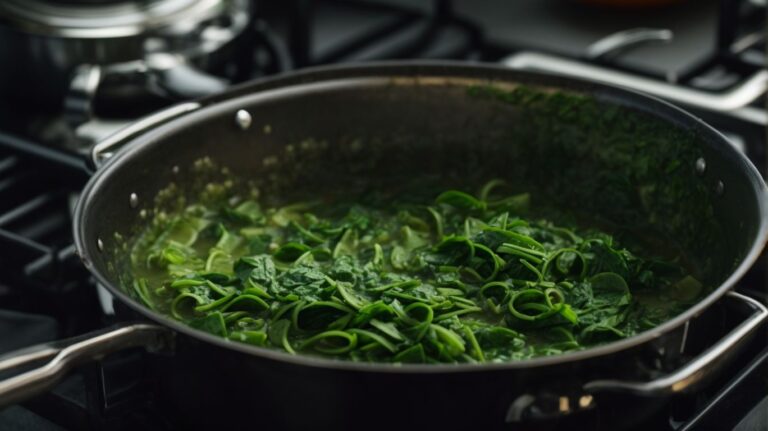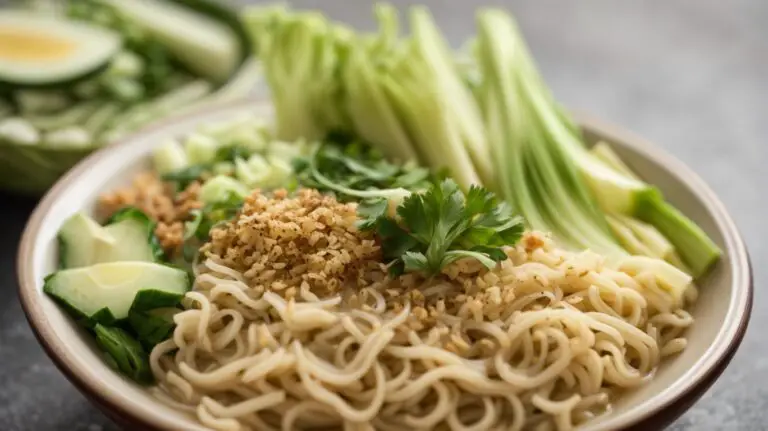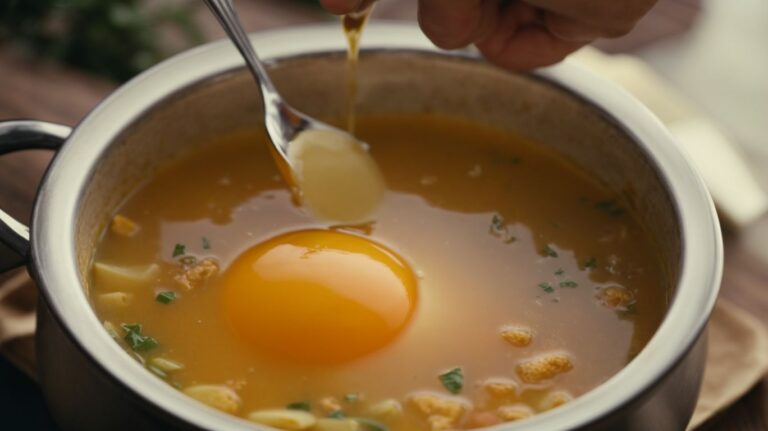How to Cook Eggs on Cast Iron?
Looking to elevate your egg-cooking game?
Consider using cast iron for the perfect breakfast staple.
In this article, we’ll explore why cast iron is the best choice for cooking eggs, how to season your pan for optimal results, tips for preparing your eggs, and a step-by-step guide to cooking eggs on cast iron.
We’ll also share essential tips for cleaning and maintaining your cast iron pan. Let’s get cracking!
Key Takeaways:
Why Use Cast Iron for Cooking Eggs?
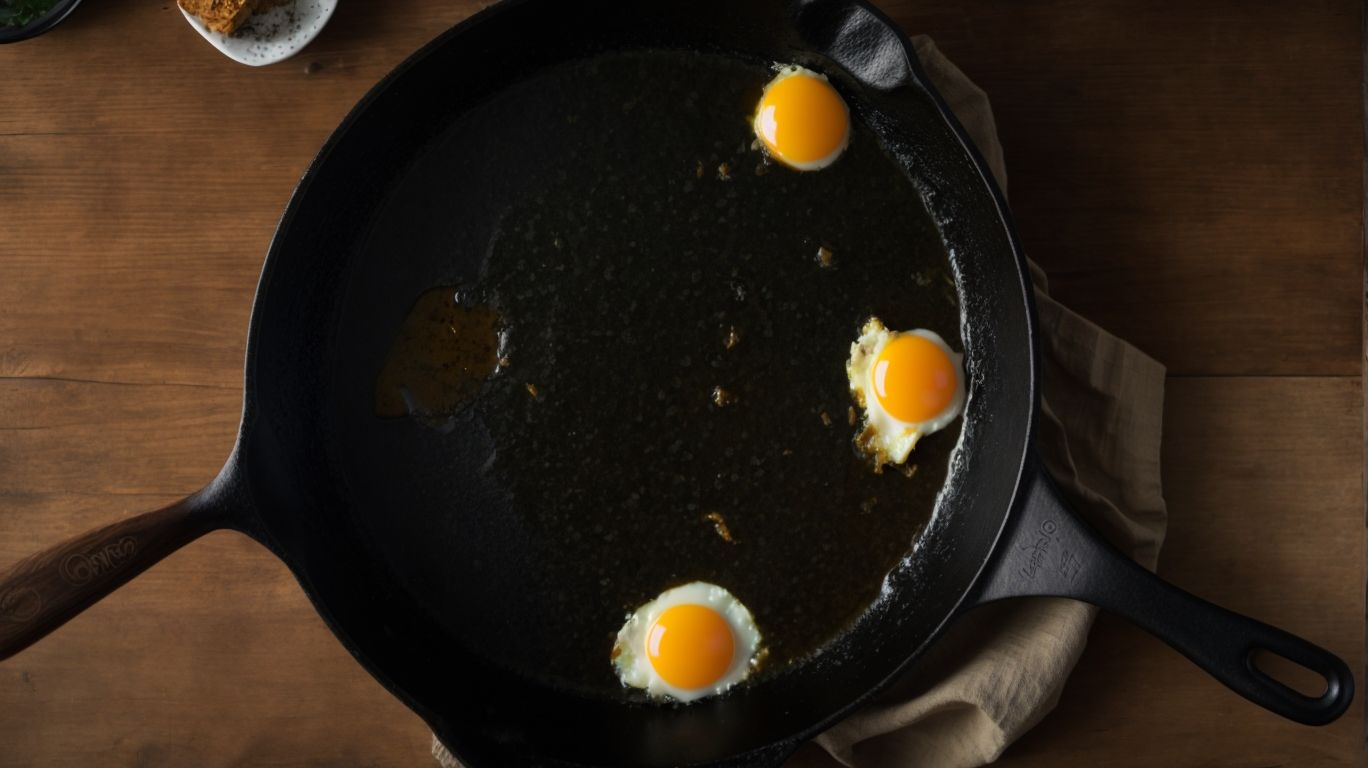
Credits: Poormet.Com – Eric Hall
Using Cast Iron for cooking eggs offers numerous benefits that enhance the overall cooking experience.
Cast Iron excels in heat retention, allowing for even cooking and perfecting those delicate eggs. The material benefits from its ability to distribute heat uniformly, avoiding hot spots and ensuring eggs cook to perfection every time. The porous surface of Cast Iron imparts a unique flavor profile to the eggs, elevating the dish with a hint of smokiness.
Take the iconic Lodge Cast Iron skillet, a staple in kitchens worldwide, as an example. This all-purpose skillet not only excels in cooking eggs but also sears a flavorful Chimichurri Steak and Eggs dish to perfection. The versatility of Cast Iron makes it the go-to choice for many home cooks and professional chefs alike.
Even Heat Distribution
Even heat distribution is crucial when cooking eggs as it ensures uniform cooking and optimal texture.
This is especially important because eggs have a delicate texture that can easily be ruined by uneven heat. When the heat is distributed evenly, it helps the eggs cook consistently and prevents any parts of the eggs from overcooking or undercooking.
To achieve this, one effective technique is to preheat the cooking surface before adding the eggs. This helps in creating a stable heat environment for the eggs to cook evenly. Different cooking methods, such as using a non-stick pan or a gentle heat source, can also aid in maintaining even heat distribution throughout the cooking process.
Non-Stick Surface
The non-stick surface of Cast Iron pans reduces the need for excessive butter or oil when cooking eggs, promoting healthier cooking practices.
This is particularly beneficial for those who are conscious of their fat intake but still desire delicious and well-cooked eggs. By using a Cast Iron pan, you can achieve a perfectly cooked egg with just a minimal amount of fat, such as a small pat of butter, a teaspoon of bacon fat, or a drizzle of avocado oil. These fats not only contribute to the rich flavor profile of the eggs but also help create a desirable texture. The non-stick feature allows for easy flipping and sliding of the eggs, ensuring that they don’t stick to the pan and break apart.
Versatility
Cast Iron pans offer versatility for cooking a wide range of egg dishes, from fluffy scrambled eggs to hearty breakfast skillets.
One popular recipe that highlights the exceptional capabilities of a cast iron pan is the Butter Swim Biscuits. These decadent, flaky biscuits are a delight to make in a well-seasoned cast iron pan. The even heat distribution ensures a perfect golden crust on the outside while keeping the inside soft and pillowy.
Cast iron pans are ideal for preparing breakfast skillets that can include a variety of ingredients like potatoes, bell peppers, sausages, and cheese. The pan’s ability to sear, sauté, and bake makes it a go-to choice for a one-pan meal that is both flavorful and satisfying.
How to Season Your Cast Iron Pan
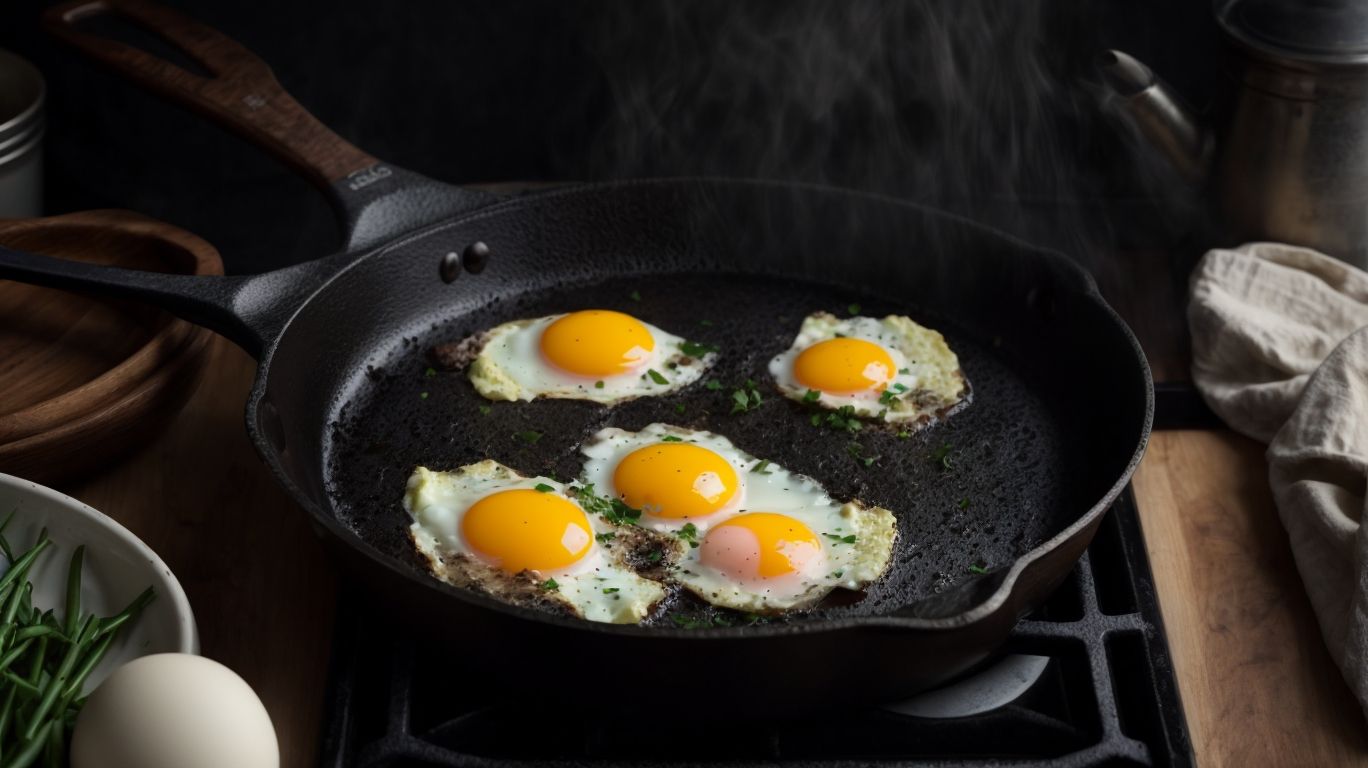
Credits: Poormet.Com – Philip Robinson
Seasoning your Cast Iron pan is essential to create a natural non-stick surface and prevent rusting over time.
Start by thoroughly cleaning your Cast Iron pan with hot water and a stiff brush to remove any food particles and debris. Dry it completely with a towel or by placing it over low heat on a stove. Next, apply a thin layer of coconut oil or vegetable oil to the entire surface of the pan, including the handle and exterior.
Preheat your oven to 350°F and place your oiled pan upside down on the oven rack. Bake for 1 hour, then turn off the oven and let the pan cool down inside. Repeat this process several times to build up a good seasoning layer.
Once properly seasoned, your Cast Iron pan will be perfect for cooking a variety of dishes, such as Mimosa Cinnamon Rolls which will slide off easily without sticking.
Clean Your Pan
Properly cleaning your Cast Iron pan after each use ensures the longevity of the surface and prevents flavor transfer between dishes.
Regarding preserving the quality of your beloved Cast Iron pan, the post-cooking cleaning routine is essential. The seasoning and integrity of the pan can be easily maintained by following some simple steps.
After each use, avoid using harsh detergents that can strip off the seasoning. Instead, opt for a gentle scrub using warm water and a soft sponge. This technique not only keeps the surface smooth but also prevents any flavor contamination in your future meals. Remember, a well-maintained Cast Iron pan is a kitchen treasure that can last for generations.
Apply Oil
Applying a thin layer of oil to your Cast Iron pan helps maintain its non-stick surface and prevents rusting.
After each use, it is crucial to oil your Cast Iron pan to protect it from oxidation and ensure its longevity. Oiling forms a protective barrier against moisture, which can lead to rust. Avocado oil or flavorful options like bacon fat are excellent choices for this task. These oils not only help in creating a seasoned coating on the pan but also add a subtle flavor to your dishes. It is a simple yet essential step in proper Cast Iron pan maintenance.
Bake in the Oven
Baking your Cast Iron pan in the oven after oil application helps create a durable seasoning layer that improves with each use.
Once you have generously applied a thin layer of oil to your Cast Iron pan, the baking process is essential to set the seasoning. Preheat your oven to the recommended temperature, usually around 375-450°F depending on the type of oil used. Place the pan upside down on the middle oven rack with a foil-covered baking sheet below to catch any drips. Let it bake for about an hour, then let it cool completely before using. This process not only enhances the pan’s non-stick properties but also prevents rusting.
Repeat the Process
Regularly repeating the seasoning process for your Cast Iron pan ensures a well-maintained surface and enhances its non-stick properties.
By applying a thin layer of canola oil or another high-smoke-point oil after each use and heating the pan gently, you are not only preventing the formation of rust but also building up a natural non-stick coating over time.
This seasoning layer not only improves the flavor of your dishes but also helps in better heat distribution, making your cooking experience more efficient and enjoyable.
Preparing Your Eggs for Cooking
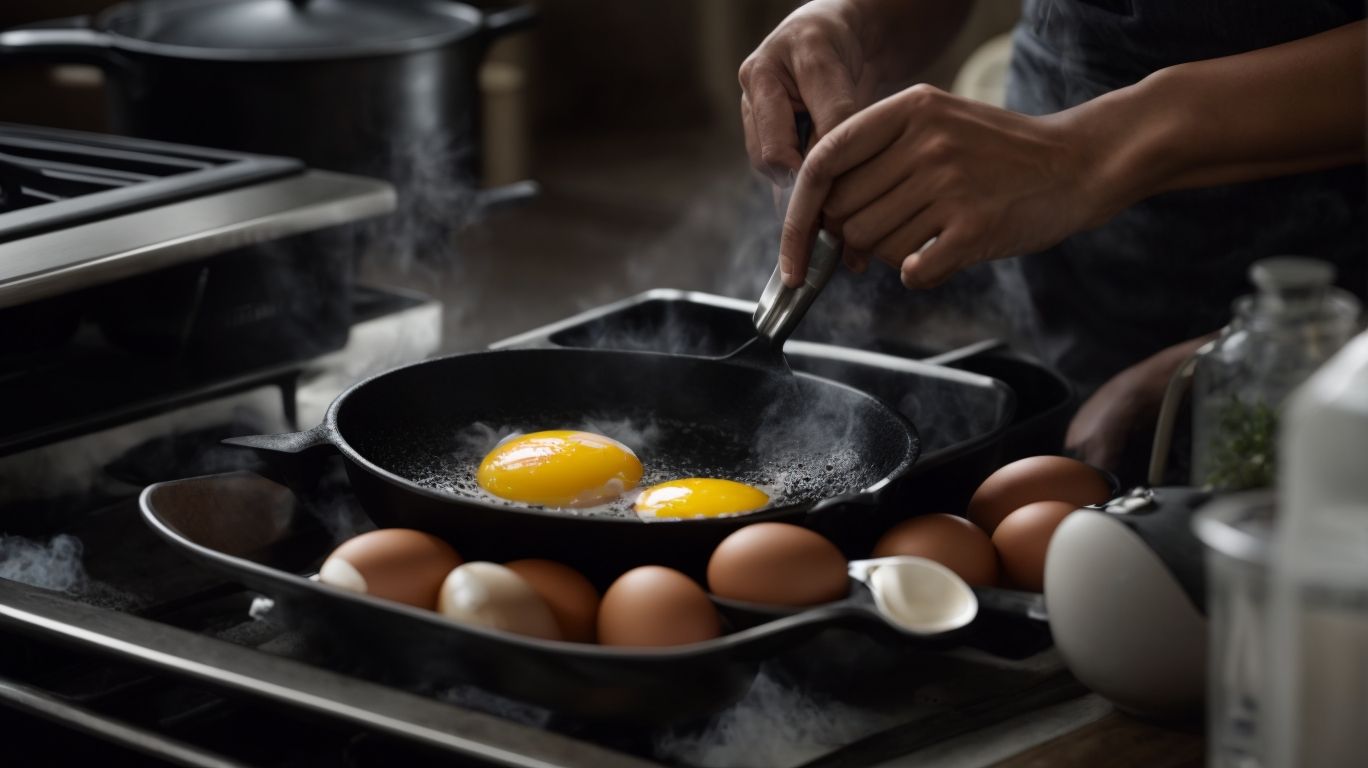
Credits: Poormet.Com – Gary Sanchez
Properly preparing your eggs before cooking is essential for achieving delicious and flavorful egg dishes.
One crucial step in the egg preparation process is to crack the eggs into a bowl, ensuring no eggshells end up in the mixture. This way, you can easily whisk the eggs together with your desired seasonings, such as salt, pepper, and cheese, to enhance the flavor profile. For a twist, you can also add ingredients like cheddar or diced ham for a savory kick.
Regarding popular egg recipes, consider trying out dishes like Briggs’ Buttermilk Biscuits, where eggs play a key role in adding richness and moisture to the biscuit dough. This showcases the versatility of eggs in various cooking methods, from baking to frying.
Choose the Right Eggs
Selecting high-quality eggs is the first step in ensuring a delicious and nutritious egg-based meal.
Regarding cooking with eggs, fresh eggs are paramount. The freshness of an egg can significantly impact the taste and texture of your dishes. An organic egg sourced from free-range chickens usually has a richer flavor profile compared to conventional eggs. The yolk of a high-quality egg tends to be firmer and more vibrant in color, enhancing the visual appeal of your creations. Different varieties, such as duck eggs or quail eggs, can also bring unique flavors and textures to your recipes, adding an exciting twist to your culinary repertoire.
Crack Eggs into a Bowl
Cracking eggs into a bowl before cooking allows for easy seasoning and ensures uniform mixing of ingredients.
This simple technique is a game-changer when it comes to creating delicious egg dishes. By cracking the eggs into a bowl first, you have better control over the seasoning, allowing you to evenly distribute salt, pepper, herbs, or spices throughout the mixture. This ensures that every bite is perfectly seasoned.
Using a bowl makes it easier to mix in other ingredients like goat cheese, parmesan, or smoked salmon. These flavorful additions can elevate your eggs to a whole new level, adding richness, creaminess, and a burst of umami flavor.
Add Seasonings and Ingredients
Adding the right seasonings and ingredients to your eggs elevates their flavor profile and enhances the overall dish.
Spicing up your eggs with a touch of Sriracha can bring a perfect balance of heat and tanginess to the dish.
Alternatively, a dollop of creamy Pesto adds a burst of herbaceous flavors that beautifully complement the natural richness of the eggs.
For a creamy and indulgent twist, consider topping your cooked eggs with slices of ripe avocado – the buttery texture and subtle flavor will take your dish to a whole new level.
These additions not only enhance the taste but also play a crucial role in altering the texture of your eggs, resulting in a more dynamic and satisfying culinary experience.
Cooking Your Eggs on Cast Iron
Cooking eggs on Cast Iron pans allows for precise heat control and flavorful results that cater to your preferences.
When cooking eggs on Cast Iron, the heat is evenly distributed across the surface, ensuring that your eggs cook evenly. This is crucial, especially when trying to achieve the perfect texture for dishes like scrambled or sunny-side-up eggs. The ability of Cast Iron pans to retain heat helps in maintaining a consistent cooking temperature, preventing hot spots that can lead to overcooking or uneven results.
Using oils like butter or bacon fat when cooking eggs on Cast Iron adds a depth of flavor that enhances the overall taste of the dish. These fats not only prevent sticking but also infuse the eggs with a delicious richness that cannot be achieved with non-stick pans.
Heat Your Pan
Ensuring your Cast Iron pan is properly heated before adding eggs is key to achieving a perfect cooking surface and preventing sticking.
Preheating your cast iron pan properly helps create a non-stick surface by allowing the pores in the pan to expand and seal, preventing the eggs from adhering too much to the surface.
- Experts recommend preheating the pan over medium-low to medium heat for about 5-10 minutes until it reaches an even temperature.
- You can test the readiness of the pan by sprinkling a bit of water onto the surface; if it sizzles and evaporates almost immediately, the pan is ready for cooking.
Add Oil or Butter
Adding a thin layer of oil or butter to your Cast Iron pan enhances flavor and promotes non-stick cooking when preparing eggs.
When using oils like coconut oil or vegetable oil, the natural richness they impart elevates the taste of your eggs, making them irresistibly delicious. The fats in the oils help create a barrier between the egg and the pan, preventing sticking and ensuring easy release.
On the other hand, butter brings a luxurious richness and a wonderful savory note to the eggs. To properly coat the Cast Iron surface, melt a small amount of oil or butter on low heat, then use a paper towel to spread it evenly across the pan. This ensures a thin, even layer that will allow the eggs to cook evenly and slide right out when done.
Pour in the Eggs
Carefully pouring cracked eggs into your prepared Cast Iron pan sets the stage for a flavorful and satisfying cooking experience.
One key aspect to keep in mind when cracking eggs into the pan is to ensure that the surface is properly preheated. This initial contact of the eggs with the hot pan helps in achieving that perfect texture and flavor.
Even distribution of the eggs is vital to ensure uniform cooking. For omelets, gently swirl the pan to spread the mixture evenly. When making a frittata, use a spatula to spread the egg mixture uniformly across the pan surface.
Cook to Your Preference
Cooking eggs on Cast Iron allows you to customize the cooking process to suit your desired texture and flavor preferences.
By experimenting with different cooking times and heat levels, you can achieve various outcomes ranging from the silky perfection of a soft-boiled egg to the rich creaminess of a scrambled egg seared on a sizzling Cast Iron skillet.
For a runny yolk, try cooking sunny-side-up eggs over medium-high heat for around three minutes, or opt for a firmer yolk by flipping the egg and cooking for an additional minute.
To enhance the flavor, consider sprinkling some grated cheese over the eggs as they cook, allowing it to melt and infuse each bite with a decadent richness.
Cleaning and Maintaining Your Cast Iron Pan
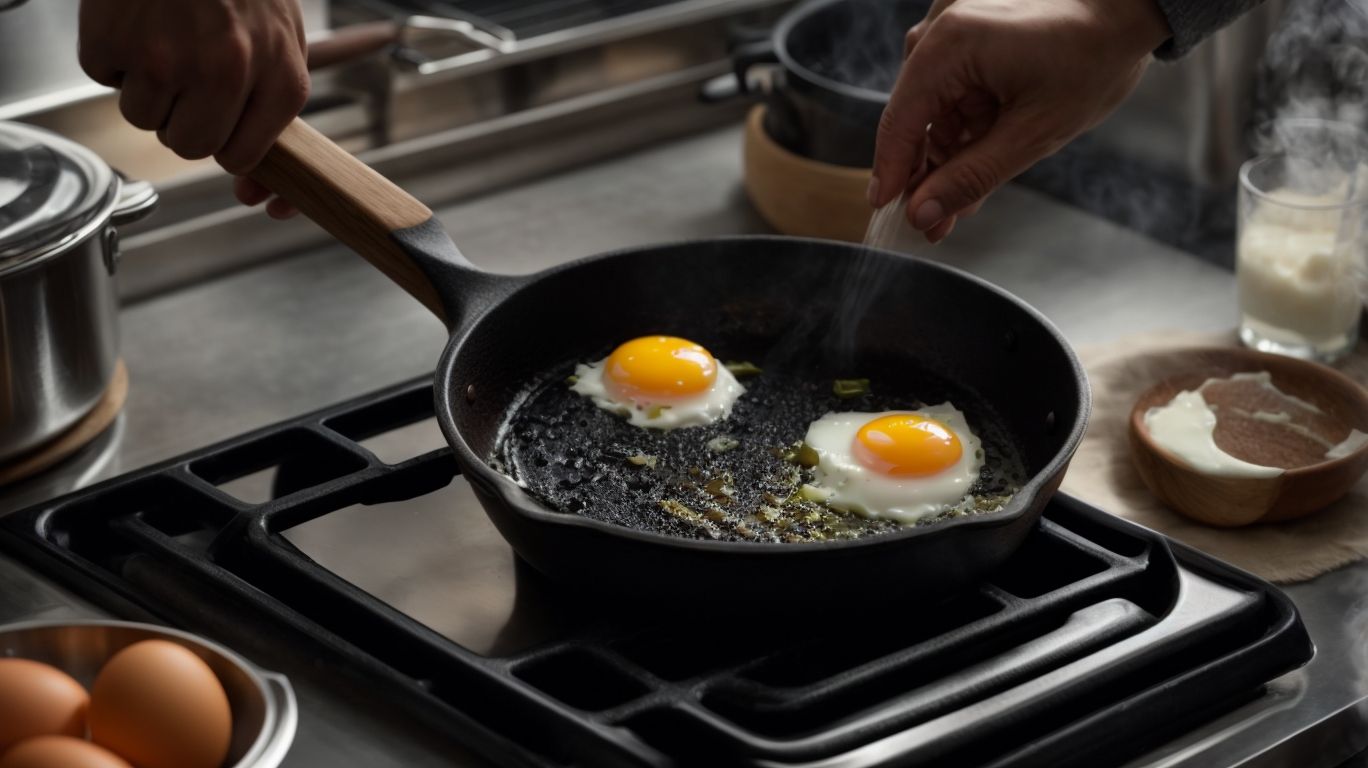
Credits: Poormet.Com – Jeffrey Rodriguez
Properly cleaning and maintaining your Cast Iron pan ensures its longevity and optimal cooking performance for years to come.
One crucial step in caring for Cast Iron cookware is ensuring it is thoroughly dry after each use. After cleaning with warm water and a gentle scrub, dry the pan completely to prevent rusting. Avoid letting it air dry as moisture can lead to corrosion.
Periodic re-seasoning is also essential to keep your Cast Iron pan in top condition. Coat it with a thin layer of canola oil and bake it in the oven at a high temperature to create a non-stick surface. This process helps maintain the pan’s seasoning and prevents food from sticking.
Clean Your Pan After Use
Cleaning your Cast Iron pan with water and gentle scrubbing after each use helps preserve its surface and prevent flavor transfer.
For effective cleaning, start by rinsing the pan with warm water while it’s still warm to remove any food debris.
Next, use a soft sponge or brush to gently scrub the surface, avoiding harsh abrasives that can damage the seasoning.
Dry the pan immediately with a towel to prevent rusting and store it in a dry place.
Regular maintenance like this not only keeps your pan in top condition but also enhances its cooking performance over time.
Dry Thoroughly
Thoroughly drying your Cast Iron pan after cleaning is essential to prevent rusting and maintain its seasoning layer.
When moisture is left on the surface of the Cast Iron pan, it can lead to the formation of rust, which not only compromises its appearance but also affects its performance.
By ensuring the pan is completely dry after washing, you are safeguarding it from the damaging effects of oxidation.
Applying a thin layer of oil post-drying serves as a protective barrier, preventing moisture from coming into direct contact with the pan’s surface and maintaining its seasoned finish.
This process not only enhances the longevity of your pan but also ensures that it remains in prime condition, ready for your next culinary adventure!
Re-Season as Needed
Re-seasoning your Cast Iron pan periodically ensures its non-stick properties and longevity for consistent cooking results.
Maintaining a seasoned Cast Iron pan involves reapplying a thin layer of oil after each use or when you notice food starting to stick. The frequency of re-seasoning depends on how often you use the pan; a good rule of thumb is to re-season every few uses. This process not only enhances the non-stick surface but also prevents rust and oxidation, prolonging the lifespan of your beloved kitchen companion. Optimal oils for re-seasoning include high-smoke-point options like avocado oil or flavorful choices such as bacon fat, imparting a rich essence to your dishes.
Frequently Asked Questions
1. How to Cook Eggs on Cast Iron?
Cooking eggs on cast iron is a simple and delicious way to start your day. Follow these steps for perfect eggs every time!
2. What type of cast iron should I use for cooking eggs?
Any type of cast iron skillet will work for cooking eggs. However, a well-seasoned and smooth cast iron is recommended for best results.
3. Do I need to use oil when cooking eggs on cast iron?
It’s recommended to use a small amount of oil, such as vegetable or canola oil, when cooking eggs on cast iron. This will prevent the eggs from sticking to the pan.
4. How do I season my cast iron skillet for cooking eggs?
To season your cast iron skillet, heat it on the stove on medium-low heat and rub a thin layer of vegetable oil onto the surface. Let it cool and wipe off any excess oil. Repeat this process a few times for a well-seasoned skillet.
5. How long should I preheat my cast iron skillet before cooking eggs?
It’s important to preheat your cast iron skillet for a few minutes on medium heat before cooking eggs. This will ensure even cooking and prevent the eggs from sticking.
6. Can I cook other ingredients with my eggs on cast iron?
Yes, you can cook other ingredients such as vegetables, meats, and cheese with your eggs on cast iron. Just make sure to add them in after the eggs have been cooking for a few minutes to prevent them from burning.

